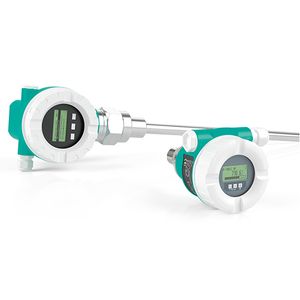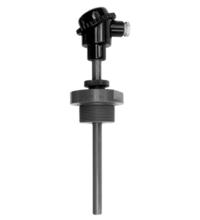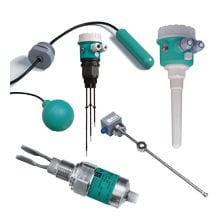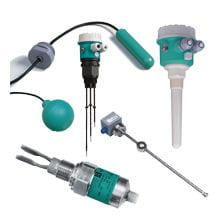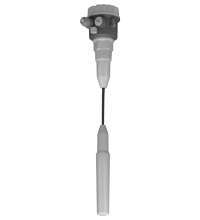Pepperl+Fuchs Level Sensors
Vibration Limit Switch
- Limit value detection for liquids as maximum detection
- High switching capacity
- Used in open or pressureless vessels
- Sensor for conductive limit value detection
- Electrodes ?PEPPERL+FUCHS/Explosion Protection/Level Measurement
- Limit switch for bulk solids
- Device with rope probe
- Rope probe can be shortened for optimum matching to the measuring point
- Complete unit consisting of the probe and electronic insert
- Integrated active build-up compensation: exact switch point, even with strong build-up
- Mechanically rugged: no wearing parts, long operating life, maintenance-free
What Are Level Sensors and Why Are They Crucial?
Level sensors are devices used to detect and measure the level of liquids, solids, or slurries within a container or process. They play a crucial role in various industrial, commercial, and residential applications where accurate monitoring and control of material levels are essential. The key functions of level sensors include measuring the quantity of a substance, preventing overflow or emptying of containers, and facilitating automation in processes. Today we are going to examine Pepperl+Fuchs level sensors in detail.
Types of Pepperl+Fuchs Level Sensors
Pepperl+Fcus produces a wide range of level sensors, let's take a closer look at level measurement solutions from this company.
Ultrasonic level sensors
These tank level indicators use ultrasonic waves to measure the distance between the sensor and the liquid surface. They are commonly used for non-contact level measurement.
Capacitive level sensors
Capacitive sensors detect changes in capacitance caused by the presence or absence of a material, such as a liquid. They are suitable for both conductive and non-conductive liquids.
Magnetic level sensors
Magnetic level sensors use the principles of magnetic field disruption to detect the liquid level. They are often used in applications where other technologies might be unsuitable, such as corrosive or high-pressure environments.
Guided wave radar level sensors
Radar level measurement uses radar technology to measure the level of liquids. Guided wave radar sensors are suitable for a wide range of applications and can be used in various industries.
Vibrating fork level sensors
Vibrating fork level sensors utilize the principle of vibrating tuning forks. The vibration changes when the fork is in contact with the liquid, allowing the sensor to detect the level.
Conductive level sensors
Conductive level sensors are designed to sense the electrical conductivity of a liquid. They are often used for point level detection in applications where conductivity changes with the level of the liquid.
Hydrostatic level sensors
These sensors measure the pressure at the bottom of a liquid column to determine the liquid level. They are suitable for applications where the density of the liquid is relatively constant.
Selecting the Right Pepperl+Fuchs Level Sensor
Selecting the right industrial level sensors involves considering several factors to ensure that the chosen sensor meets the specific requirements of your application. Here are key considerations to help guide your selection.
- Different level sensors are designed for specific materials, such as liquids, solids, or slurries. Ensure that the sensor you choose is suitable for the physical and chemical properties of the material in your application.
- Consider the range over which you need to measure the level. Some sensors are designed for short-range applications, while others are suitable for long-range measurements. Choose a sensor with an appropriate measurement range for your specific needs.
- Determine the level of accuracy required for your application. Some processes demand high precision, while others may tolerate a lower level of accuracy. Select a level sensor that meets the accuracy requirements of your application.
- Consider the environmental conditions of the installation site. Factors such as temperature, humidity, and exposure to corrosive substances can impact sensor performance. Pepperl+Fuchs offers sensors with varying degrees of environmental protection, so choose one that can withstand the conditions of your operating environment.
- Evaluate the space available for sensor installation and the mounting options provided by Pepperl+Fuchs. Some sensors are designed for direct insertion into tanks, while others may be installed externally. Ensure that the chosen sensor is compatible with your installation requirements.
- Determine the output signal required for your control system (e.g., analog, digital, or relay outputs). Additionally, consider the communication protocol if the sensor needs to interface with other devices or a control system.
- Check the power supply requirements of the sensor. Ensure that the available power source aligns with the sensor's specifications.
- Consider the ease of maintenance and calibration. Some sensors may require periodic calibration, and you should assess whether the maintenance procedures align with your operational requirements.
- Ensure that the selected level sensor complies with relevant industry standards and regulations. Depending on the application, certifications such as ATEX or IECEx may be necessary for hazardous environments.
- Pepperl+Fuchs offers a range of level sensors with specific features tailored to different applications. Identify any unique requirements for your application and choose a sensor that includes the necessary features.
Installation and Maintenance of Pepperl+Fuchs Level Sensors
The installation and maintenance of Pepperl+Fuchs level switches are critical to ensuring their proper functioning and longevity. Below are general guidelines for installing and maintaining Pepperl+Fuchs level sensors.
- Before installation, thoroughly read the product manual provided by Pepperl+Fuchs. It contains specific instructions and guidelines for the installation of the particular level sensor model.
- Choose a suitable location for sensor installation based on the application requirements. Consider factors such as the material being measured, environmental conditions, and access for maintenance.
- Follow the recommended mounting instructions provided in the product manual. Ensure that the sensor is securely mounted to prevent vibrations or movement that could affect its accuracy.
- Make electrical connections according to the specifications in the product manual. Pay attention to proper grounding and follow any guidelines for avoiding electromagnetic interference.
- Calibrate the level sensor according to the manufacturer's recommendations. Calibration ensures accurate measurement and should be performed regularly, especially if there are changes in the process or environmental conditions.
- If the installation environment exposes the sensor to moisture or harsh substances, use appropriate seals and protection to prevent damage. Pepperl+Fuchs sensors often come with different levels of environmental protection, so choose the appropriate model for your application.
- Conduct regular visual inspections of the level sensor to check for signs of damage, corrosion, or wear. If any issues are identified, address them promptly.
- Keep the sensor clean from debris, buildup, or any material that could affect its performance. Use mild cleaning agents as recommended by the manufacturer, and avoid abrasive materials that could damage the sensor's surface.
- Periodically verify the calibration of the level sensor to ensure accurate measurements. Recalibrate the sensor if necessary, especially after any maintenance or changes to the process.
- If the sensor is exposed to extreme environmental conditions, monitor its performance and take appropriate measures to protect it. This may include additional weatherproofing or insulation.
- Inspect the electrical connections for signs of corrosion or loose connections. Ensure that the wiring is secure and in good condition.
- If the level sensor has firmware or software components, check for updates provided by Pepperl+Fuchs. Keeping the firmware/software up-to-date can enhance performance and address any known issues.
